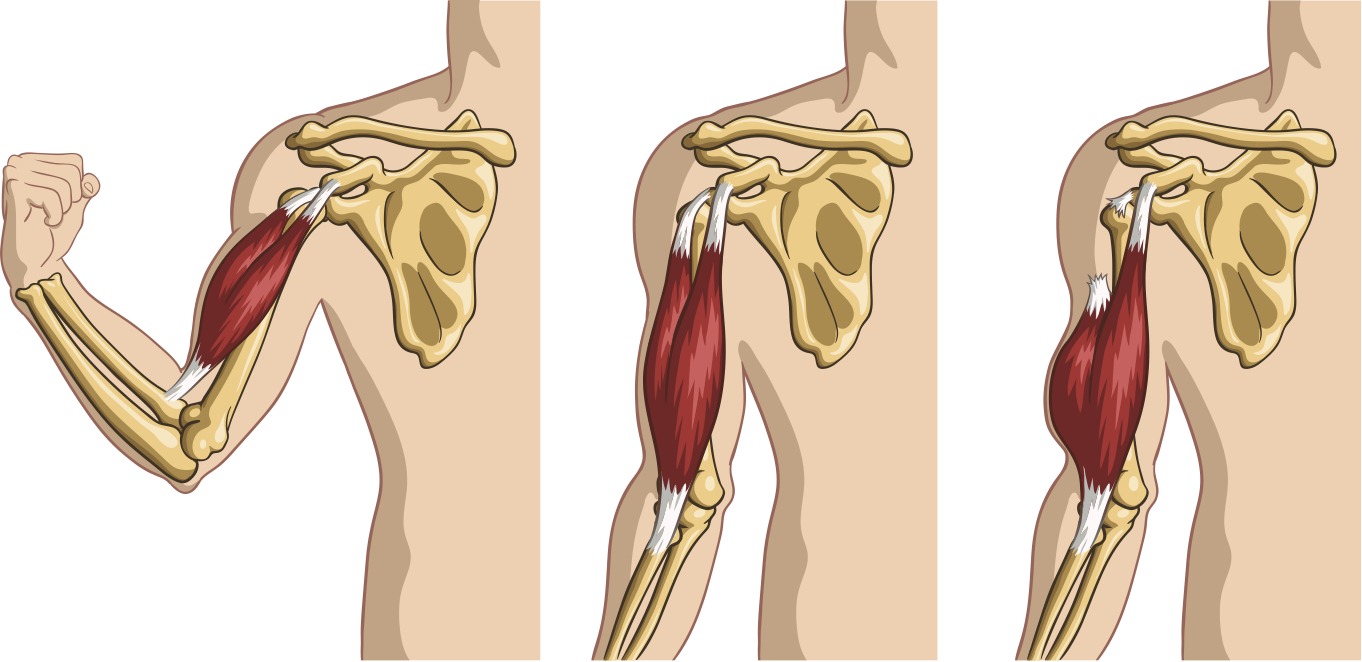What is a biceps tendon tear and tendonitis?
The upper end of the biceps muscle has two tendons that attach it to bones in the shoulder. The long head attaches to the top of the shoulder socket (glenoid). The short head attaches to a
bump on the shoulder blade called the coracoid process. Through a traumatic injury or overuse, the biceps tendon can tear or become inflamed. Shoulder and sports medicine specialist serving Boulder, Colorado, Dr. Austin Chen is available to discuss and treat bicep tendon tears and tendonitis.
There are two types of biceps tendon tears, partial or complete.
- Partial tears. Many tears do not completely sever the tendon.
- Complete tears. A complete tear will split the tendon into two pieces.

What is the cause of a biceps tendon tear or tendonitis?
There are two main causes of biceps tendon tears: injury and overuse.
Injury: If you fall hard on an outstretched arm or lift something too heavy, you can tear your biceps tendon.
Overuse: Many tears are the result of a wearing down and fraying of the tendon that occurs slowly over time. This naturally occurs as we age. It can be worsened by overuse – repeating the same shoulder motions again and again. Overuse can cause a range of shoulder problems, including tendinitis, shoulder impingement, and rotator cuff injuries. Having any of these conditions puts more stress on the biceps tendon, making it more likely to weaken or tear.The long head of the biceps tendon is more likely to be injured because it is vulnerable. Fortunately, the biceps has two attachments at the shoulder and the short head of the biceps rarely tears. Because of this, most people find that they can still use their biceps even after a complete tear. When you tear your biceps tendon, you can also damage other parts of your shoulder, such as the rotator cuff tendons.
What are the risk factors for a biceps tendon tear or tendonitis?
The following risk factors for a biceps tendon tear or tendonitis:
- Age. Older people have put more years of wear and tear on their tendons than younger people.
- Heavy overhead activities. Too much load during weightlifting is a prime example of this risk, but many jobs require heavy overhead lifting and put excess wear and tear on the tendons.
- Shoulder overuse. Repetitive overhead sports, such as swimming or tennis, can cause more tendon wear and tear.
- Smoking. Nicotine use can affect nutrition in the tendon.
- Corticosteroid medications. Using corticosteroids has been linked to increased muscle and tendon weakness.
What are the symptoms for a biceps tendon tear or tendonitis?
- If the tear is a complete tear in the proximal tendon (near the shoulder), the bicep muscle may roll down and form a muscular ball, known as a “Popeye sign” (image). Symptoms of a full biceps tendon tear include sharp, sudden pain in the upper arm, and in some cases, an audible pop or snap. Symptoms may also include pain or tenderness near the shoulder, difficulty flexing the elbow and rotating the forearm.
- Sudden, sharp pain in the upper arm
- Sometimes an audible pop or snap
- Cramping of the biceps muscle with strenuous use of the arm
- Bruising from the middle of the upper arm down toward the elbow
- Pain or tenderness at the shoulder and the elbow
- Weakness in the shoulder and the elbow
- Difficulty turning the arm palm up or palm down
- Because a torn tendon can no longer keep the biceps muscle tight, a bulge in the upper arm above the elbow (“Popeye Muscle”) may appear, with a dent closer to the shoulder.
What are the treatment options for biceps tendon tears or tendonitis?
For a partial tear, non-surgical treatment is recommended. This includes rest, ice, anti-inflammatories and physical therapy to help restore muscular strength and flexibility.
Surgical treatment is rarely needed for a long head of the biceps tendon tear. However, those who develop cramping or pain, or who require complete recovery of strength, such as athletes or manual laborers, Dr. Chen may suggest surgery. In cases of partial tears that do not respond to non-surgical treatment, surgery may also be the right choice.
Surgical treatment, known as a biceps tenodesis, is an option for those who do not have relief or improvement from conservative methods. In this surgery, Dr. Austin Chen cuts the attachment of the biceps tendon from the inside of the shoulder joint and then reattaches it to the upper arm (humerus bone) using a small screw or suture. Dr. Chen performs the surgery using small incisions near the front of the armpit with a tiny camera and surgical instruments to make the repairs.
